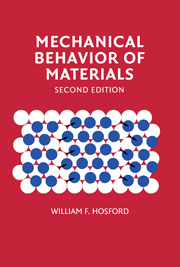Book contents
- Frontmatter
- Contents
- Preface
- 1 Stress and Strain
- 2 Elasticity
- 3 Mechanical Testing
- 4 Strain Hardening of Metals
- 5 Plasticity Theory
- 6 Strain Rate and Temperature Dependence of Flow Stress
- 7 Slip and Crystallographic Textures
- 8 Dislocation Geometry and Energy
- 9 Dislocation Mechanics
- 10 Mechanical Twinning and Martenitic Shear
- 11 Hardening Mechanisms in Metals
- 12 Discontinuous and Inhomogeneous Deformation
- 13 Ductility and Fracture
- 14 Fracture Mechanics
- 15 Viscoelasticity
- 16 Creep and Stress Rupture
- 17 Fatigue
- 18 Residual Stresses
- 19 Ceramics and Glasses
- 20 Polymers
- 21 Composites
- 22 Mechanical Working
- APPENDIX I Miller Indices
- APPENDIX II Stereographic Representation of Orientations
- Index
APPENDIX I - Miller Indices
Published online by Cambridge University Press: 05 June 2012
- Frontmatter
- Contents
- Preface
- 1 Stress and Strain
- 2 Elasticity
- 3 Mechanical Testing
- 4 Strain Hardening of Metals
- 5 Plasticity Theory
- 6 Strain Rate and Temperature Dependence of Flow Stress
- 7 Slip and Crystallographic Textures
- 8 Dislocation Geometry and Energy
- 9 Dislocation Mechanics
- 10 Mechanical Twinning and Martenitic Shear
- 11 Hardening Mechanisms in Metals
- 12 Discontinuous and Inhomogeneous Deformation
- 13 Ductility and Fracture
- 14 Fracture Mechanics
- 15 Viscoelasticity
- 16 Creep and Stress Rupture
- 17 Fatigue
- 18 Residual Stresses
- 19 Ceramics and Glasses
- 20 Polymers
- 21 Composites
- 22 Mechanical Working
- APPENDIX I Miller Indices
- APPENDIX II Stereographic Representation of Orientations
- Index
Summary
Planes
Planes in a crystal are identified by their Miller indices. The system involves;
Writing the intercepts on the three axes;
Taking the reciprocals;
Reducing these to the lowest set of integers in the same ratio;
Enclosing in parentheses.
EXAMPLE PROBLEM AI.1: Write the Miller indices of the two planes shown in Figure AI.1.
Solution: For plane a:
The intercepts on the three axes are 1, ∞, and 1. Note that the y intercept is taken as ∞ because the plane does not intercept the y axis.
Reciprocals are 1, 0, and 1.
These are already reduced to lowest set of integers in same ratio.
The plane is (101).
For plane b:
The intercepts on the three axes are 1, −1, and 1/2. Note that the plane has to be extended out of the cubic element to intercept the y axis at −.
Reciprocals are 1, −1, and 2.
These are already reduced to lowest set of integers in same ratio.
The plane is (112). Note that the minus sign is indicated by an over bar and that no commas are used.
Directions
Directions are indicated by their components parallel to the three axes reduced to the lowest set of integers and enclosed in brackets, [].
- Type
- Chapter
- Information
- Mechanical Behavior of Materials , pp. 407 - 411Publisher: Cambridge University PressPrint publication year: 2009



